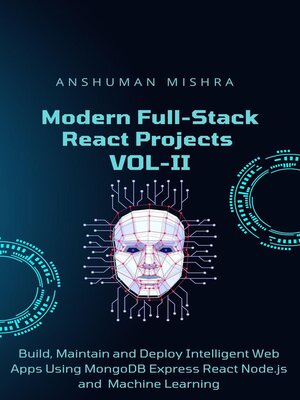Modern Full-Stack React Projects VOL-II
ebook ∣ Python Full Stack, #6 · Python Full Stack
By Anshuman Mishra

Sign up to save your library
With an OverDrive account, you can save your favorite libraries for at-a-glance information about availability. Find out more about OverDrive accounts.
Find this title in Libby, the library reading app by OverDrive.



Search for a digital library with this title
Title found at these libraries:
| Library Name | Distance |
|---|---|
| Loading... |
Node.js, and Machine Learning
In the age of artificial intelligence and automation, businesses and applications are shifting beyond traditional web development into the realm of intelligent digital platforms — where applications don't just serve static content but respond, adapt, and learn from user behavior and data. This book is designed to bridge that very gap. It's a complete, hands-on guide to building modern, intelligent full-stack applications using the powerful MERN stack (MongoDB, Express, React, Node.js) — integrated with Python and Machine Learning models.
Whether you're a student preparing for your tech career, a professional developer looking to level up, or a data scientist wanting to see your models in action — this book will empower you to design, build, and deploy end-to-end intelligent web applications from scratch. It goes beyond CRUD apps and static dashboards; here, you'll learn how to build systems that think, analyze, and respond — all in real-time.
This book brings together three critical pillars: modern full-stack development, data science integration, and real-world deployment practices.
We begin by exploring the purpose and power of modern full-stack intelligence. You'll understand what it means to combine user interfaces, data pipelines, machine learning logic, and DevOps practices into a unified system. We explain how these components interact in real-world scenarios — from building a feedback classification system to deploying intelligent recommendations in live apps. The chapter also sets up the tools and environments you'll need — Git, Node.js, MongoDB, VS Code, Python, and cloud services — preparing you for development in a modern ecosystem.
The journey continues into frontend development using modern React. You'll learn how to build dynamic, responsive interfaces using functional components, React Hooks, and efficient state management with Context API and Redux Toolkit. We'll also explore how React integrates with REST APIs and how libraries like Chart.js and D3.js can help visualize data interactively — a key skill in building user-facing analytics, dashboards, and prediction interfaces.
On the backend side, we dive deep into Node.js and Express.js, teaching you how to build robust RESTful APIs that interact seamlessly with frontend and database layers. You'll learn how to manage API endpoints, handle user authentication using JWT, apply middleware, and organize your backend code using modular design. This not only ensures scalability but also sets the foundation for integrating AI logic and external services.
With the backend foundation in place, you'll move into the database layer with MongoDB. Unlike traditional relational databases, MongoDB's flexible schema design makes it an ideal choice for full-stack apps that include AI components, logs, and user-generated data. You'll learn how to design data models, store real-time predictions, capture user interactions, and run complex queries using MongoDB's aggregation framework. MongoDB Atlas and Compass are also introduced to simplify remote access and data visualization.
Now that you've built the basic stack, the book transitions into machine learning integration using Python. We take you through building ML models with Scikit-learn, preprocessing data using Pandas, and training basic classifiers and regressors. But instead of stopping at notebooks, you'll learn how to deploy these models as REST APIs using Flask or FastAPI, and consume them directly in your Node.js app. The integration between Python and Node is handled via RESTful APIs or child processes, offering flexible options...







